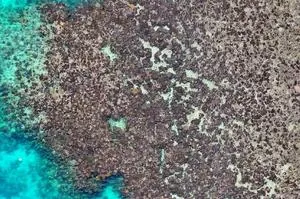
Staggering Coral Mortality Uncovered by Drones After Devastating Bleaching Event
2025-07-04
Author: Yu
In a shocking revelation, new research indicates that coral mortality rates soared to an alarming 92% following last year's bleaching catastrophe at Lizard Island, part of Queensland's iconic Great Barrier Reef. This represents one of the most catastrophic coral die-offs ever recorded globally.
Conducted by a multidisciplinary team led by Dr. Vincent Raoult from Griffith University, the study assessed the fallout of the Fourth Global Coral Bleaching Event, officially declared by NOAA in April 2024. This widespread event has wreaked havoc across the reef system, intensifying concern for coral ecosystems.
Researchers meticulously analyzed 20 distinct sections of reef, each measuring 10m x 10m, encompassing both northern and southern regions of Lizard Island. What they encountered was staggering: an average of 96% of corals in the surveyed areas displayed signs of bleaching.
Dr. Raoult emphasized the unprecedented nature of these findings, stating, "Even with relatively lower heat stress levels at Lizard Island compared to other parts of the reef, the recorded mortality is alarming. This highlights the vulnerable state of coral ecosystems as they face escalating challenges from climate change, especially after the devastating global bleaching event of 2024."
Professor Jane Williamson, a senior author on the study from Macquarie University, echoed the urgency of addressing climate change as she reflected on the findings. She stated, "Our results are alarming for coral resilience, particularly with the increasing frequency of extreme heat events that may have irreversible effects on reef ecosystems like those in our Great Barrier Reef."
Utilizing state-of-the-art drone technology, the research team captured high-resolution imagery to document coral health before and after the bleaching incident. In March 2024, they mapped the extent of bleaching and then returned in June to evaluate survival rates.
The drones, including the DJI Mini 3 Pro and Autel Evo II, allowed for precise tracking of bleached and living corals over expansive areas. Remarkably, some locations recorded coral mortality rates exceeding 99%, and no significant differences were detected between the northern (North Point Reef) and southern (Palfrey Island Reef) sites.
Despite facing relatively moderate heat stress conditions (with temperatures rising 6°C over several weeks), coral mortality levels surpassed historical records for Lizard Island. Past disturbances, including severe bleaching events in 2016 and 2017, cyclones, and Crown-of-Thorns outbreaks, have compounded the reef's vulnerability, despite some signs of recovery in recent years.
The research team is committed to long-term monitoring efforts and will conduct further surveys at Lizard Island until 2026, aiming to track any potential coral recovery as part of an Australian Museum Critical Grant.
This eye-opening study, titled 'Coral bleaching and mass mortality at Lizard Island revealed by drone imagery,' has been published in the journal Coral Reefs, reinforcing the urgent call to safeguard our coral ecosystems before it's too late.



 Brasil (PT)
Brasil (PT)
 Canada (EN)
Canada (EN)
 Chile (ES)
Chile (ES)
 Česko (CS)
Česko (CS)
 대한민국 (KO)
대한민국 (KO)
 España (ES)
España (ES)
 France (FR)
France (FR)
 Hong Kong (EN)
Hong Kong (EN)
 Italia (IT)
Italia (IT)
 日本 (JA)
日本 (JA)
 Magyarország (HU)
Magyarország (HU)
 Norge (NO)
Norge (NO)
 Polska (PL)
Polska (PL)
 Schweiz (DE)
Schweiz (DE)
 Singapore (EN)
Singapore (EN)
 Sverige (SV)
Sverige (SV)
 Suomi (FI)
Suomi (FI)
 Türkiye (TR)
Türkiye (TR)
 الإمارات العربية المتحدة (AR)
الإمارات العربية المتحدة (AR)